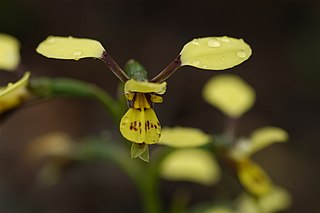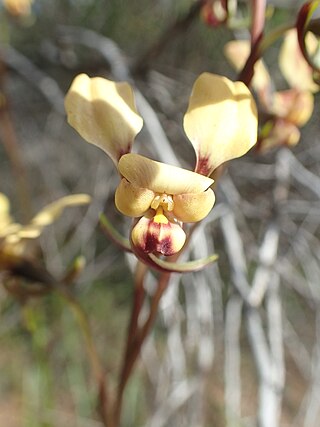Diuris maculata, commonly known as the spotted doubletail, is a species of orchid endemic to New South Wales. It has up to two or three folded leaves and a flowering stem with up to eight yellow flowers with brown to blackish markings. It is similar to D. pardina which has darker flowers with larger brown markings.

Diuris behrii, commonly known as golden cowslips, is a species of orchid which is endemic to southern continental Australia. It has between three and six grass-like leaves and a flowering stem with up to four drooping, yellow flowers with dark streaks on the labellum. The flowers appear between September and November in its native range.

Diuris sulphurea, commonly called the tiger orchid or hornet orchid, is a species of orchid which is endemic to eastern Australia. It has up to three leaves, and a flowering stem with up to seven bright yellow flowers with dark brown markings.

Diuris laxiflora, commonly known as bee orchid, is a species of orchid which is endemic to the southwest of Western Australia. It has two to five narrowly linear leaves and up to six yellow flowers with brown markings. It is a small orchid, common within its range and about half the size of the common donkey orchid, Diuris corymbosa.

Diuris praecox, commonly known as the early doubletail, Newcastle doubletail or rough doubletail is a species of orchid which is endemic to New South Wales. It has two or three grass-like leaves and up to ten light yellow flowers with a few dark brown marks. It is threatened by urbanisation.

Diuris monticola, commonly known as highland golden moths, is a species of orchid that is endemic to south-eastern Australia. It is a common and widespread, late flowering species growing in grassland and woodland habitats at higher altitudes. It has a tuft of up to nine leaves at the base and up to four slightly drooping bright yellow flowers with dark streaks in the centre.
Diuris striata is a poorly-known species of orchid that is endemic to New South Wales. It has a two grass-like leaves and about four mauve flowers with dark purple streaks on the labellum.

Diuris tricolor, commonly known as the long-tailed donkey orchid or pine donkey orchid, is a species of orchid that is endemic to eastern Australia. It has up to three grass-like leaves and up to six orange-coloured to yellow flowers with white and purplish tints. The lateral sepals are unusually long.
Diuris brevifolia is a species of orchid that is endemic to South Australia. It usually has one or two grass-like leaves and a flowering stem with up to five bright yellow and reddish-brown flowers with purple stalks.
Diuris insignis, commonly known as dark bee orchid, is a species of orchid that is endemic to the south-west of Western Australia. It has between two and six narrowly linear to thread-like leaves and up to five yellow flowers with many dark red markings.
Diuris inundata is a species of orchid that is endemic to south-eastern continental Australia. It usually has between three and six grass-like leaves and a flowering stem with one or two pale yellow to buttercup yellow flowers with a few rusty-red specks.

Diuris leopardina is a species of orchid that is endemic to south-eastern continental Australia. It has between two or three grass-like leaves of different lengths, and a flowering stem with up to five pale yellow to butter yellow flowers with reddish brown or purple marks and patterns, and leopard-like spots on the back.

Diuris ostrina, commonly known as Darling Scarp donkey orchid, is a species of orchid that is endemic to the south-west of Western Australia. It has two or three linear to lance-shaped leaves and up to five brown to brownish-yellow and purple-mauve flowers.
Diuris pallescens, commonly known as pale donkey orchid, is a species of orchid that is endemic to the south-west of Western Australia. It has two or three linear to lance-shaped leaves and up to seven pale yellow flowers with light brown to reddish-brown markings.

Diuris porphyrochila, commonly known as Yalgorup donkey orchid, is a species of orchid that is endemic to the south-west of Western Australia. It has two or three linear to lance-shaped leaves and a flowering stem with up to eight yellow flowers with brown to reddish-brown and purple markings.

Diuris refracta, commonly known as dainty donkey orchid, is a species of orchid that is endemic to the south-west of Western Australia. It has two or three linear to lance-shaped leaves and up to six yellow flowers with reddish markings.
Diuris segregata, commonly known as Northampton bee orchid, is a species of orchid that is endemic to the south-west of Western Australia. It has between two and six narrowly linear to thread-like leaves and up to three yellow flowers, usually with dark red markings.

Diuris septentrionalis, commonly known as northern bee orchid, is a species of orchid that is endemic to the south-west of Western Australia. It has two or three linear leaves and up to five yellow flowers with dark red markings.
Diuris systena, commonly known as New England golden moths, is a species of orchid that is endemic to the Northern Tablelands of New South Wales. It has two or three grass-like, narrowly linear leaves and up to four lemon yellow and brownish-green flowers.
Diuris tinctoria, commonly known as sandplain donkey orchid, is a species of orchid that is endemic to the south-west of Western Australia. It has two or three linear to lance-shaped leaves and two to five pale yellow flowers suffused with light brown.











